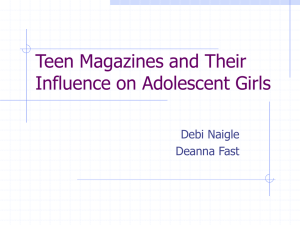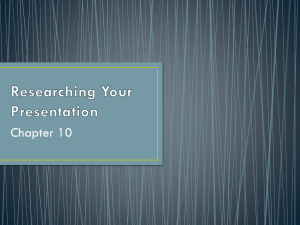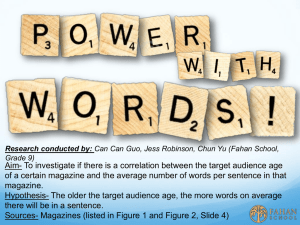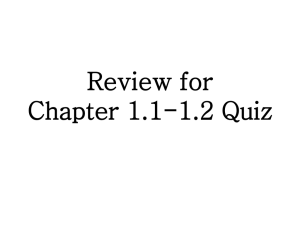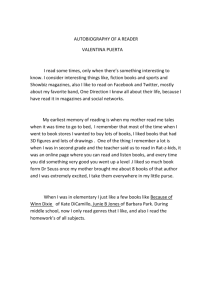View Paper
advertisement
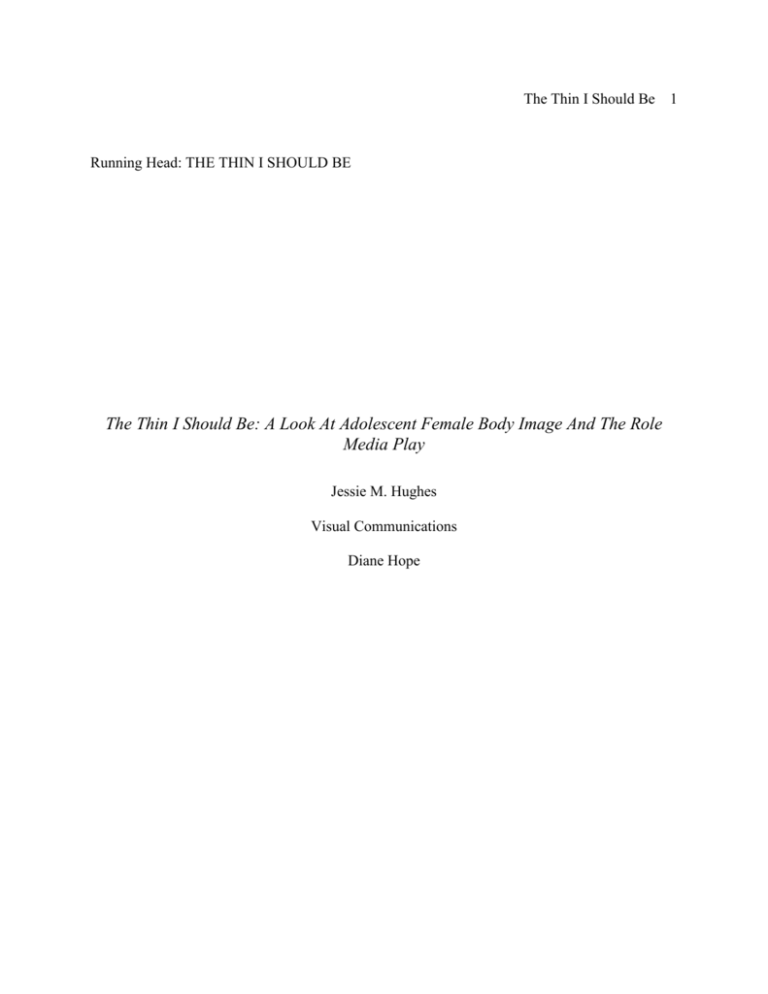
The Thin I Should Be Running Head: THE THIN I SHOULD BE The Thin I Should Be: A Look At Adolescent Female Body Image And The Role Media Play Jessie M. Hughes Visual Communications Diane Hope 1 The Thin I Should Be 2 Abstract: There is are multiple research studies into whether media images in fashion magazines affect female adolescents and their body image. The standard for woman has changed dramatically over the decades and as a result adolescent females are beginning to pay the price. This paper provides an in-depth look into the effects that these thin-ideal images have on youths, particularly female adolescents ages 11-15. The paper explores some of the key factors that contribute to female adolescents’ body image, reviews the literature that explores the impact of images in fashion magazines, explores positives and negatives of exposure to these images, and hypothesizes what could be done to change the existing harmful effects of these images. Sufficient evidence will be shown about the effects of extremely thin models in fashion magazines on female adolescents who are in the influential developmental stage. The Thin I Should Be 3 There are multiple research studies into whether media images in fashion magazines affect female adolescents and their body image. The purpose of this paper is to look further into the effects that these thin-ideal images have on youths particularly female adolescents ages 11-15. The following will look at the some of the key factors that contribute to female adolescents and body image, review the literature that explores the impact of images in fashion magazines, explore positives and negatives of exposure to these images, and hypothesize what could be done to change the existing harmful effects of these images. Many communication and media theories can be applied to this area of research to help understand why adolescent females relate to body images in magazines. Leon Festinger’s theory of cognitive dissonance developed in 1957 stated that the existence of dissonant cognitions produces an uncomfortable feeling that needs resolution. This feeling then motivates the individual to lessen or alleviate the dissonance (Baran & Davis, 2006).Girls who measure themselves against the unrealistic images they see in magazines experience dissonance regarding their own self worth. Even when a female adolescent feels at ease with her body there can be dissonance caused by images portrayed in fashion magazines of ultra thin models that may not align with her already formed cognitions. In other words these images can cause internal discomfort, and girls seek to ease the dissonance by changing themselves to fit the image. Uses and Gratifications theory ( Blumer & Katz, 1974) can be applied showing that images in magazines can be used as a comparison for what female adolescents desire to look like. Images can be chosen as a form of media use for adolescents trying to attain a certain ideal body image. These magazines and the images in them serve as guidelines and a source of The Thin I Should Be 4 information for youths. The goal of this study is to point out the effects of extremely thin models in fashion magazines on female adolescents who are in the influential developmental stage. A brief history of the ideal body type of women is necessary so that we may see how these ideals have changed throughout the decades and, surprisingly how in many ways they have stayed the same. Throughout history, the dominant political climate and cultural ideals always have shaped the public’s perception of the ideal female body type. However, today’s culture is unique in that the media (including television, Internet, movies, and print) is a far more powerful presence than ever before (Derenne & Beresin, 2006, para. 3). The ideal body type for women has changed with the times. In colonial times survival was an important factor and women needed to be strong and able to work and bear children. In the 19th century tiny waists and large breasts were of the utmost value. A change came with the emergence of corsets and was followed by the women’s movement in the 20th century and the popularity of the thin boyish flapper (Derenne & Beresin, 2006, para. 7). During World War II women were asked to work and were once again valued for being strong and hard working. Following the war women went back to the home and back to assuming the traditional role of wife and mother. The 1960’s saw the beginning of the presence of thin models such as Twiggy, and the emergence of ultra thin models such as Kate Moss in the 1980’s further pushed thin as the ideal (Derenne & Beresin, 2006, para. 9). The number of thin models is growing and increased pressure is being put on female adolescents to be thin. Derene and Beresin (2006) state “Twenty-five years ago, the average fashion model was 8 percent thinner than the average The Thin I Should Be 5 woman, and today that number has risen to 23 percent” ( page?). “Body-image can be conceptualized as multi-dimensional and representative to how individuals think, feel, and behave with regard to their own physical attributes" says Muth & Cash (as cited in Morrison et al., 2004, p. 571). Body image and dissatisfaction in adolescent females can be seen as a pre-existing outlook that can be fueled by media images in magazines. The environment of female youths is a contributing factor to their perpetuated ideal body image. “They gradually internalize the gaze of others, and are aware of this constant evaluation which leads them to self monitor and in turn judge their own appearance“(Advertising Educational Foundation Inc., 2003). There is a direct correlation between body image and self esteem in adolescents. Self-esteem is defined as “a positive or negative attitude… toward the self.” (Rosenberg, 1965) The development of self esteem and changes in body type between the ages of 11 and 15 can add to female body dissatisfaction, and can be the gateway for media images to have a heightened effect. In a recent study of the media’s thin ideal and adolescents, it was noted that adolescents can recognize image value given by the media and then see media images as important in furthering their success in their social world, however they can not distinguish fantasy from reality (Harrison, 2002). The increased dissonance in their perceptions of their worth in the world may lead to negative behaviors. Body image is central to adolescent girls’ self-definition, because they have been socialized to believe that appearance is an important basis for self-evaluation and for public evaluation (Thompson, Heinberg, Altabe, & Tantleff-Dunn, 1999). In most cases as we become adults we struggle to find ways to change or mold ourselves to societal norms and values. We attempt to The Thin I Should Be 6 take control of factors that we believe will make us more acceptable to society. Adolescent females go through changes that they do not fully understand and thus they do not see themselves in a positive way in comparison to what is portrayed by the media. Due to the hidden messages in media images, many girls think that a thinner body can ultimately lead to a better way of life and can gain them greater acceptance by those around them. The Dittmar study (2000) states: The desire for thinness is most problematic during adolescence when the body is still growing. It is ironic that at the age of 15, when crises of identity and anxieties about attractiveness are at their most acute, girls typically experience an increase in the distribution of fat around their hips and thighs, further denying them the contemporary cultural ideal (Dittmar et al., 2000). Models in magazines serve as role models for young females. Adolescence maturity progressions from generation to generation is more rapid than the last, and images in magazines tend to direct their marketing to this factor. What starts as looking at magazines for entertainment is quickly internalized and causes female adolescents to judge themselves. An adolescent who believes that people in the media represent ideals of appearance, behavior, or lifestyle may not only identify with these, but also compare him or herself to them (Anderson et al., 2001). “It has been documented that by late elementary, half of girls are reading fashion magazines, 25 percent are reading them weekly, and by middle school over 40 percent are reading them to get beauty information” (Advertising Educational Foundation Inc., 2003). Fashion magazines and the images in them are becoming a staple resource for young girls The Thin I Should Be 7 and what they perceive to be standards in society today. Research demonstrates that adolescent females are directly affected by the stereotypes and thin images depicted in mainstream fashion magazines. “Many adolescents are concerned with bodily characteristics and physical attractiveness, and the media are filled with people who exemplify a cultural ideal of beauty that is difficult for most adolescents to attain. For females, a critical part of this ideal is being thin” (Anderson et al.,2001). Adolescents often times tend to relate themselves to images portrayed by the media and attempt to change themselves accordingly. Advertising through fashion magazines can be seen as one of the contributors to female adolescents poor sense of self and extreme longing to align themselves with the ideals depicted in those magazines. Many studies have been conducted about the effect of images in fashion magazines that may cause a damaging, long-term, negative perception by adolescents. A few of these studies will be used to support claims that advertising images in fashion magazines do have a severe and negative effect on female adolescents and their already fragile mental development. Highly popular fashion magazines such as Seventeen magazine, Teen, Ym, Vogue, Cosmopolitan, and a few others are at the center of interest for young girls ages 11 to 15. These fashion magazines tend to target the younger females who are in early stages of development as opposed to having already reached young adulthood. Other fashion magazines mentioned seem to follow the trend in that they are the most appealing reading material for fashion and health advice. “It has been argued that woman’s beauty and fashion magazines actually place an emphasis on physical beautification as the primary form of self-improvement and self-development and, in so doing, reinforce the cultural preference for thinness” (Thomsen, Weber, & Brown, 2002, p. 14). The Thin I Should Be 8 In the study of the effects of media-portrayed thin-ideal images on vulnerable girls, a random sample group of 219 adolescent girls ranging from ages 13 to 17 were assigned to a 15month fashion magazine subscription or no-subscription and were then followed over time (Stice, Spangler, & Agras, 2001). Seventeen magazine was chosen in particular due to its overwhelming popularity with young girls. The Cusumano and Thompson (1997) study also shows that the models that are portrayed in this magazine are ultra slender (as cited in Stice et al., 2001). The study found that exposure to thin-ideal images resulted in a greater negative affect for vulnerable adolescents by creating pressure to be thin, body dissatisfaction, and that the images increased body dissatisfaction and self image for female adolescents who were lacking strong positive social support (Stice et al., 2001.) Although this study did not evaluate exposure over long periods of time, it did reinforce the implication that images in fashion magazines can cause a negative effect on young girls who are dealing with body dissatisfaction and the pressure to be thin. Another area of study assess the influence of media images on female youths and their weight concerns: [P]ictures in magazines had a strong impact on girl’s perceptions of their weight and shape. Of the girls, 69 percent reported that pictures in magazines influence their idea of the perfect body shape, and 47 percent reported wanting to lose weight because of magazine pictures (Field et al.,1999, p. 660). Girls that read fashion magazines were more likely to diet and exercise frequently, and to look to these publications for ideal body shape rather than those that did not. The majority of female The Thin I Should Be 9 adolescents in this study were unhappy with their shape and body weight and were directly affected by the print media and images used in fashion magazines (Field et al., 1999). These studies demonstrate the magazines that are listed above can play a pivotal role in the lives of females adolescents as a form of parenting, positive or negative reinforcement, social acceptance, standard setting, and as an overall guideline for youths to follow and compare themselves to. The images used in these publications are unrealistic and many times far below the standard of healthy body weight and shape. Many of the popular fashion magazines being read by girls include information on how to slim down, change your body, and an array of other tips that are used to promote healthy lifestyle when in turn they provide ideas for female adolescents wanting to maintain thin-ideals (Maltby et al., 2005). Of the magazines that were evaluated, Seventeen and Glamour were listed as the fashion magazines with the most appealing standards for the ideal body. Richins (1991) conducted a study in which the short-term effects of advertising stimuli are measured. Richins (1991) looked at idealized models in advertising and their use to target young adult females. Although there were not lasting effects, in the short term there were comparisons in body and style to that of the models used in advertising. Many times what young females see in magazines is what they use to judge themselves and their outward appearance. This research reaffirms that media images do have an effect on adolescent girls and their body image. More often than not there is a need to compare oneself to images that are portrayed as the ideal body image. The thin-ideal in magazines has become a main concern because the images are becoming increasingly more unrealistic and female youths are pushing themselves beyond their physical The Thin I Should Be 10 boundaries in order to be thin. These findings have lead to the idea that “body dissatisfaction results from the discrepancies between female’s actual body size, and an ideal size strongly influenced by images in the media” (Dunkley, Wertheim, Paxton, 2002, p. ?). A severe side effect of the extent to which girls will go to be thin includes eating disorders such as anorexia and bulimia. When researching a link between reading beauty and fashion magazines and eating disorders, researchers Thomsen, Weber, and Brown (2002) found that reading magazines causes many young woman to internalize the thin-ideal and try to attain it through various practices such as calorie restriction, appetite suppressants, weight loss pills, vomiting, skipping meals, and using laxatives (Thomsen et al., 2002). Exposure to thin-ideal magazine content is related to increased anorexia, and among high school aged females, increased bulimia (Harrison 2002). Throughout the studies examined, there is overwhelming evidence to support the claim that female adolescents are affected in one way or another by media images in fashion magazines. It was found that in many cases dissatisfaction with self and increased pressure from the media causes many girls to develop multiple types of eating disorders to mold themselves into what they see in magazines. Although there is substantial evidence that thin model images in fashion magazines do have an effect on female adolescents and their body image, there is also evidence that if used positively, these images can be beneficial to female youths that are overweight. When examining exposure to mass media and weight concerns among girls, Field et al found,, [The] frequency of reading fashion magazines was positively associated with the frequency of having dieted to lose weight, having gone on a diet because of a magazine The Thin I Should Be 11 article, exercising to lose weight or improve body shape, and deciding to exercise because of a magazine article. The results suggest that the print media aimed at young girls could serve a public health role by refraining from relying on models who are severely underweight and printing more articles on the benefit of physical activity (Field et al., 1999, p. 660). This supports the claim that if used in positive ways images of models in fashion magazines could help female youths to adopt healthier living habits. Many adolescents are overweight and they view media images as reinforcement for diet and exercise. Suggestions for further research include studying what might happen if these magazine images were portrayed in a way that did not idealize thinness, and to discover how they might serve a greater purpose in promoting a healthy lifestyle. Even though female weight has seemed to increase, the images in fashion magazines are still increasingly thin and unrealistic (Maltby et al., 2005). If the female images used in fashion magazines better represented actual girls, the majority of readers might have an increased positive response. After careful research and review it is clear that there is a negative affect caused by media images in fashion magazines. There has been an overall pressure for females to conform to what society’s body image standards are. It seems today, more than ever, that female adolescents are affected by images in fashion magazines and in some cases are going to extremes to achieve the same look. It could be argued that images would not negatively affect female youth if those images could be presented in a positive and constructive way. Unfortunately, much of the The Thin I Should Be 12 images presented in fashion magazines are that of ultra-thin, emaciated women. Further research could be done to determine why advertisers choose these images to represent the ideal body image, and what images could be used as an alternative. It would also be beneficial to research the backlash against thinner models contrasted against the presence of such a large demand to use them as spokespeople for the average product in a magazine. Now that the importance placed on body images for female adolescents can be seen it is time to take a step in a healthier more realistic direction for the sake of our developing girls. The Thin I Should Be 13 References Advertising Educational Foundation inc (Producer). (2003, October). How is Advertising Shaping The Image Of Women. [conference]. Chicago: Northwestern University. Anderson, D., Huston, A., Schmitt, K., Linebarger, D., Wright, J., & Wright, J. (2001). IX. Self Image: Role Model Preference And Body Image. Monographs of the Society for Research in Child Development, 66(1), 108-118. Baran, S., & Davis, D., (2006). Mass Communication Theory (4th ed.). Belmont: Thompson. Derenne, J. L.,& Beresin, E.V. (2006, June). Body image, media, and eating disorders. Academic Psychiatry, 30, 257-261. Dittmar, H., Lloyd, B., Dugan, S., Halliwell, E., Jacobs, N., & Cramer, H. (2000). The "body beautiful": English adolescents' images of ideal bodies. Sex Roles, 42, -915. Dunkley, T., Wertheim, E., & Paxton, S. (2001, January 1). Examination of a Model of Multiple Sociocultural Influences on Adolescent Girls' Body Dissatisfaction and Dietary Restraint. Adolescence, 36(142), 265. Field, A., Cheung, L., Wolf, A., Herzog, D., Gortmaker, S., & Colditz, G. (1999, March). Exposure to the Mass Media and Weight Concerns Among Girls. Pediatrics, 103(3), 660. Retrieved September 26, 2007, from Academic Search Elite database. Harrison, K. (2000, June). The body electric: Thin-ideal media and eating disorders in adolescents. Journal of Communication, 50(3), 119-143. Retrieved September 18, 2007, The Thin I Should Be 14 from PsycINFO database. Maltby, J., Giles, D., Barber, L., & McCutcheon, L. (2005, February). Intense-personal celebrity worship and body image: Evidence of a link among female adolescents. British Journal of Health Psychology, 10(1), 17-32. Morrison, T., Kalin, R., & Morrison, M. (2004, Fall). Body-image evaluation and body-image among adolescents: A test of sociocultural and social comparison theories. Adolescence, 39(155), 571-592. Richins, M. (1991, June). Social comparison and the idealized images of advertising. Journal of Consumer Research, 18(1), 71-83. Rosenberg, M. (1965). Society and the adolescent self-image. Princeton, NJ: Princeton University Press. Stice, E., Spangler, D., & Agras, W. (2001, September). Exposure to media-portrayed thin-ideal images adversely affects vulnerable girls: A longitudinal experiment. Journal of Social & Clinical Psychology, 20(3), 270-288. Thomsen, S., Weber, M., & Brown, L. (2002, Spring). The relationship between reading beauty and fashion magazines and the use of pathogenic dieting methods among adolescent females. Adolescence, 37(145), 1.

